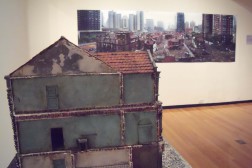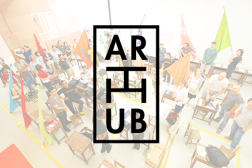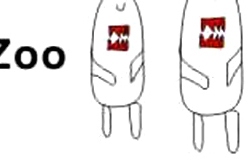
Text by Lothar Spree: Is there really space for creativity?
A text dedicated to the possible founding of (another) cultural center in Shanghai. Written by Lothar Spree (Tongji University) and Davide Quadrio.
Education is an admirable thing, but it is well to remember from time to time that nothing that is worth knowing can be taught.
– Oscar Wilde
When in 2003, the Cultural Development Study for Shanghai was commissioned by the World Bank, Shanghai, we got involved in this project that tried to come up with concepts for the development of Shanghai, a city of modern life style, as a model for the urban future of China. We got involved in the discussion because the project called on an undefined group of independent artists, curators, gallerists and critics, to become part of an official think tank, which was located between private and official organizations involved in art and culture in Shanghai. The question, posed by the officials of the city government, was: how to make Shanghai fit for the new Millennium. Since then, this question has been gaining urgency.
Resource Management
The contemporary lifestyle of a city requires–among things like financial power, economic attractiveness, logistics and urban infrastructure–a factor that concerns the vitality, recreation and adaptability of the entire urban life–creativity, i.e. art and culture. At that time, one significant answer, already converted into factual existence, was the idea of Creative clusters, presented by – among others – M50). By that time, alliances of creative people, private initiatives, commercial endeavors, freelance studios and galleries constituted not only an idea – they were already the fact that gave Shanghai culturally and internationally the reputation of a dynamic centre of art and life style.
798/M50/2010
At that time, there existed only a few creative clusters in China yet–798 in Beijing was more like a rumor, and M50 had just been starting up, presented by BizArt, ShanghArt and others. And they were independent initiatives-–not instigated or fostered by official politics. What seemed then to many a discussion about unnecessary luxuries, is by now a broad and impatient public discourse about How to present the city and the nation at the prestigious show of cultural and industrial abilities–the World Exhibition 2010 in Shanghai?
From early times until today, one underlying question determines the discourse about this development: what is creativity? and how do you generate creativity? The need for creativity is widely recognized–it is no longer a point of luxury but of social survival. It is no longer a question of art only; the pursuit of creativity has been recognized as a question of national and global economic stability and security. In fact, the recognition that creativity constitutes a necessity, has become more relevant in areas of industrial production and development, in scientific research and in economic planning and decision making–far more urgent than in the (still for many: secondary) field of the arts. Additionally, the introduction of what is called Creative Industries, put in a leading position on the ranking list of important issues, has only drastically emphasized the problem.
Money and More
Yet certainly, there thrives the common attitude, that creativity is helpful to make more money, to sell better or to use it as an advertising tool. Not only, but especially in media industries, creativity is the matter that secures existence and growing of companies and businesses. But more importantly, any other industry or services will in future depend increasingly on novelty, innovation, development, inventiveness–and in order to institutionalize an education for this, research and experimentation has to be fostered. Certainly, and that seems to be recognized by the government, this is a national, all encompassing task, but each company and institution also has to make this to its own and individual assignment.
To instigate and maintain, or even to provoke constant creativity in a company requires a lot of so far unusual and in itself, innovative measures. The business world, by necessity, has to come up with measures that are not in a direct way profitable, but in an indirect way. This might require a new kind of thinking that poses questions like the responsibility of the individual for the common, of the privileged for the social average, or of the rich to the economically unsuccessful; it requires a list of new and unusual means of implementing creative changes. One such provision can be a private/public institute for developing conditions for creative activities and results–a Creativity Centre similar to the one we would like to bring into the discussion here.
Overall, the question remains–how to define creativity and how to nurture it?–we have to find an approach to the answer that is both conceptual in its long-range perspective and effective in its short-time results. In the long-range version, it has to create a process that ensures a vision, a goal that carries endeavors forward for a long time across arid fields of difficulties and doubt. In an immediate range, it has to be practical and directly supportive and effective, also in a business sense. The method of work has to be a continuation of the principle of creativity, a process of permanent self-rejuvenation. While the long-range perspective has to offer a durable platform for focused development, considering not only the short-sighted profit aspects, the practical side of the process has to ‘pay off’ in a direct and business-related public relations effect. But in any case, both sides of the coin are based on research, experimentation, innovation, plus a routine of continuous active education–all mixed in with a good shot of passion and daring.
China!
As written often and everywhere, education in China cannot offer the basis for what is needed here–the Chinese educational tradition has incredible difficulties in stimulating kids to creativity and self-determination. Although there is a lot of literature on this topic, effective changes in the system are not visible yet. The future everybody is talking about is coming closer, and since there seems to be no progress in this education system, we need to go ahead with individual, privately motivated and organized, independently financed strong supportive actions.
In our conversation with many artists in China, one particular expression we found interesting to highlight was this: the education system in China reflects what is defined as a “circular system”, repeating over and over a standardized educational framework. But if this is the system in place how can we respond to the call by the Government in China to foster creativity?
There are models, like the ones mentioned above (although they “educate” only in a very informal, indirect and slow way), and by now, there is a thriving scene of creative clusters and/or creative centers in Shanghai that all are more or less working on the question. Many organizations, especially in visual art, have been trying to support creativity, the e-Art adventure of the city of Shanghai is a very visible endeavor in that direction. But in order to support educational structures towards this goal, it is necessary to find places where art can generate creativity. This is not easy since most places are appreciative exhibition spaces, and not places of development or production.
Framework
In the realm of contemporary visual art everything seems to be about the products and the market. But of all the creative aspects, the most important ones are the basics of creativity. A theoretical discourse about the present, the past and the future of Chinese culture, possibly combined with analytical, associative and slightly anarchistic methods, is necessary. Missing is the theoretical approach to the present situation–a reference to the past, in order to build possibilities for creativity development of the future. All art of human beings, including visual art, media art, architecture, music, dance and performances, concurs to create a framework for such a development. But presently, China is still denying parts of the past, while it is reaching out to the ideal of a future of high tech creativity.
We think that the opening of the Olympic Games in Beijing stated very well this uneasiness about the recent Communist past. All the history of China was called in the opening ceremony except the communist period and the “liberation”. The past was the Confucian past connected magically to the future via the immense technology used. The final moment, with Li Ning flying around the bird’s nest was also a symbolic and ideal success story: where creativity was implemented to make money.
Said that, in this respect, it is the right time and the right context to try building an active platform for a program that should enable the encounter of professionals, businessmen, architects, artists, academics, politicians, and foundations to achieve, from a strong Asian perspective, creativity in all its forms. The question is who will be up to this task and more important, how can this platform be created and supported both by the private and public sector?
Shanghai
If there are no avenues for government supported, politically inclined, but artistically free institutions, the private sector of national and regional economy has to take up the task of preparing the ground for creative energies. This is full of dangers–for the simple reason that the New never replaces the Old in a diplomatic rondo, but challenges and questions the basics of the Old in a fundamental way. The dream that the battle between Old and New, between Tradition and the Futuristic, between the Experienced and the Utopian, between the Proven and the Risky may be peaceful and planned and manageable is nothing but a dream. It would be a surprise if the governing forces would not understand this. Yet, under the label of the “harmonious society” they shy away from and avoid the confrontation of these opposites.
The eArt Event of the city is nothing but an exhibition of things that come together in a relatively arbitrary fashion–none of the works that have the privilege of being exhibited originated in a frame of support or organization. Political intent is there, but guidance or support is left undefined. Instead, it seems to be accepted that art has to mushroom, bloom or thrive uncontrollably. But at the same time it is expected, that this flourishing brings nice, harmless, integratable or inoffensive works. And it will, at least in the Shanghai context.
Why do we seemingly want to harp on the unpleasant, controversial, critical aspects of creativity? Why do we seem to support the negative, the problematic, the ugly side of everything? Well, we don’t and this is very important to mention – BUT we demand a thorough and fruitful examination of the processes that are responsible for new, progressive and positive results. It is not a question of a negative, controversial or provocative attitude–it is simply a question of what is called a critical approach or constructive criticism.
As Davide Quadrio wrote in a recent text for the exhibition catalogue for artist Meng Huang, it seems this problem needs to be associated to the dream of the “harmonious society”:
[…] the particularly difficult problem of personal and collective identities in China. The following argument creates a disconcerting yet provocative analysis of the single against the numerous, the individual versus the collective. This relationship between the single who “exists” only as part of the “collective” is commonly accepted by Chinese people, analyzed by artists, writers and intellectuals, and often advocated by the Government to push social cohesion and political stability: the Chinese dream of a harmonious civilization. The slogans of the various communist campaigns, including the recent ones for the Olympics games, all stress this need of creating a collective (ping’an).
If the intention of not only the Chinese (or Shanghainese) governing powers is, to foster creativity and rejuvenation, they try hard to do this in an orderly fashion. To establish creativity in an acceptable, nice, constructive, productive and harmonious way. And why should this not be possible?
An animated metaphor, a simple case
For a number of years, the Chinese government has invested a huge amount of money into the industry of animated movies. Animation movies coming from US, Britain or Japan, mainly Pixar, Disney and Aardman, seem to follow very simple rules–funny stories, funny characters, funny design–all in a fantasy world without much real world context. It seems, that compared to high-cost Hollywood movie productions, animated films are relatively easy to conceptionalize, to calculate, to produce and to market–a seemingly easy way of making returns and high profits on investments.
There are by now hundreds of animation departments at universities and colleges in China, numerous production centers have been funded and supported across the country, lots of money and energy went into this field. But so far, all endeavors to get this industry running on an internationally or even only on a national, lucrative level, are not successful. What are the reasons?
There is no investigation into this question, there are no exact figures, there are not even movies we can remember that could be called a convincing result in this creativity education and investment. Instead, there is the feeling that there is a lack of substance of the matter; the very characteristic of what is called the Medium of Animation Movies, or Comics or Cartoons, has been missing. With all technical ability and educated skills, the essence of the matter has not been captured. And what might this essence be?
Harmony and Entertainment
In our consideration, the people who make successful animation movies must be highly conscious individuals who are able to differentiate themselves from the norm, the so called average, even if they had and have to fight for their art bitterly and tragically, as is often the case, to live their lives the way they decide or want to or have to. This is not a matter of elitism, of luxury or decadence; it is a question of individuality. They very well may appear crazy, lazy, irresponsible, unresponsive, asocial, strange and so on, but they are (at least theoretically) able to live these lives different from the norm, from the usual, outside of the general harmony.
And only through this difference is there harmony. This seems to be one of the key metaphors of this discussion–the difference between consonance (a body or structure vibrating in one frequency) and harmony. All the talk and propaganda about the “harmonious society” might be, half consciously, about “consonance”, this unisonous sound and one-dimensional vibration. Harmony is a complex, universe-embracing structure made up of a variety of differences, not equals, modulating a mathematically complex wave structure that embraces a high number of different frequencies and sets them in relation to each other. It is not one sound, it is a complexity of sounds that results in more than the sum of its parts–not in one sound or one tone, but in a harmony, an accord. In the wave pattern of harmony, the off-sound may get integrated or not, might meet with other frequencies and add to complex new ones, but the simple idea is that for the future of mankind it is vital to think of harmonies and not of consonances. With the complexity of harmonious structures, their liveliness and intensity will rise too, getting richer and stronger–harmonies can be entertaining, too!
In this respect, every artist or creative person will be confronted with the question of their relationship to the society, as if there would be a great distance. In modern society the artist fears to disintegrate as an artist and disappear in entropy when they integrate themselves into the norm–a fear of loosing power together with individuality. How is the artist to create art, which is the exceptional, the advanced, the special, the essence of now or the inkling of the coming if he drowns in the middle, the everage, the mediocre?
Education vs. Creativity?
Consider this, it is more than obvious how difficult it must be to propose educational measures for replacing creativity with art. Especially in the Chinese context, it is legitimate to work with this replacement–the very qualities of art are at the center of any discussion about creativity, freedom of creation, and how to govern progress.
We believe that the education to art is a highly risky, daring and energy-consuming undertaking. How should it be possible without the parameter of trust in the students? How can you order someone to create something new when at the same time you want to determine and govern him? What is he to create new if he is obedient to you? He should not even rely on the governance of his own head, because all these represent the Old. If the New is not something that never existed before, it will not be new.
The method to learn and teach Creativity is to fell all limitations and rules, to open all avenues and to forget all agreements i.e. to be free. To teach means to eliminate all expectations, to learn means to forget all rewards. Teaching means to fight for the freedom of the students and also their own inner-liberation. Teachers will be lonely. Studying means to find the untouched paths in your thinking, to let the thoughts go free, to pull out the stakes of fear, hopes, beliefs and desires. The only guide and meeting point will be an indefinable quality.
Qualifications to navigate in a sea of creativity
There is no other way of dealing with the question of “Educational Creativity” than to talk about quality. It is a term describing the constitution of something in regards to its possible condition in being itself very truly. Each object has parameters connected to it–each parameter is a scale of grades, each grade signifies a condition of parts of the object in relation to characteristics of values. These values are put up against the condition of the object and compared with possible optimum grades. Though this sounds complicated, it usually is a relatively simple procedure, considered that the desired values are related to real life.
Usually the parameters for quality derive from the known purpose or meaning of an object and can be measured against an experienced or desired condition of the object. If you desire a crisp, yellow fresh pear, you will judge a dark brown, stocky and mushy pear as of bad quality (smart, right?). According to Mao Zedong you will have to bite and eat it to get its taste, which is something the essence of its quality, as you will find out. If you see students’ works and have an idea about the requirements of the trade, or had experience with students before, you will be able to judge the work against the experience, the requirements of the outside world or your own aims.
This has to be explained so carefully only because the category of Quality has disappeared in modern times and China is picking up on this phenomenon really fast. Everything is measured more according to quantity and purpose than to the inherent characteristics of a thing, a work, an event, a product. Too often the sheer existence, the symbolic gesture, the sketchy idea are taken for sufficient and satisfying. More often quantity and size are taken for proof of quality. Materiality and quantity are enough–for now, for the moment, for this aim, for that purpose; everything is “flow” and nothing needs to be of “stock”, and keeping stock is too cumbersome and too ineffective for the Now, even if it might be necessary for the Then.
How can this vacillating thing, quality, be a meeting point for this debate or for the vast assignment of building an education to creativity? It is the only floating platform in an agitated sea of arguments and opinions.
Industrialized Creativity?
But for the discussion towards an educational impetus, whether as a center or a program or an independent initiative in form of collectives or groups (schools), it is necessary to formulate qualities required: open resources, access, discussion, production. Constant critical appraisement, something that for many seems to hinder the free evolvement, is actually invigorating for the creative process. But any active fostering of creativity in educational processes should not go as far as to become industrialized in nature.
Methodological procedures will sooner or later be something that the “Creative Industries” will have to employ in order to produce creativity industrially–if this is even possible, and more importantly if it is desirable. No matter what, it is a case of vital importance for any society, to look into its future potential of rejuvenation, regeneration and re-creation. This should not only happen because of inevitable pressures requiring changes, it should happen as a civilized and deliberate process, daring investments in the unknown, i.e. trusting in the social desire and endeavoring for the sustainable social life. Means and equipment, spaces and time have to be made available in a creative society. At all levels discussion and discourse should be understood as a constructive and contributing asset, especially when it is critical. Production should be supported by all involved and with all means. Even if it requires that all theoretical, philosophical, historical or critical elaborations have to support the materialization and concretization of ideas, not the other way around.
© Lothar Spree, Berlin, 27 July 2008
Davide Quadrio, Bangkok, 10 october 2008




